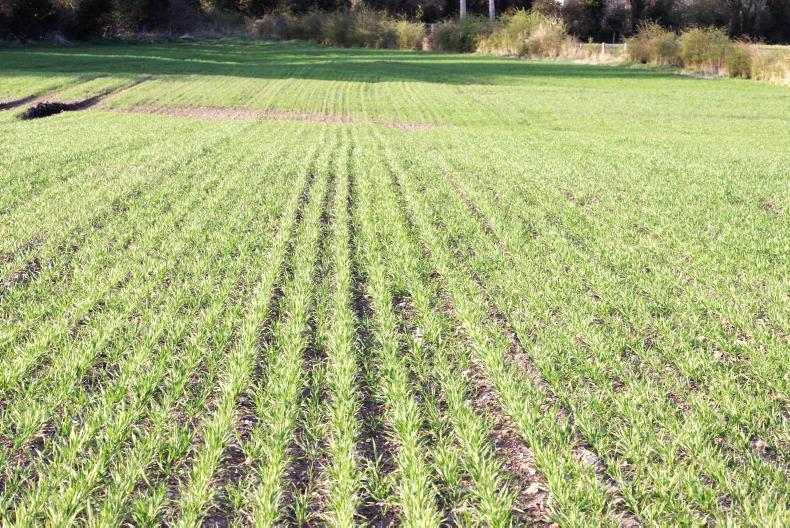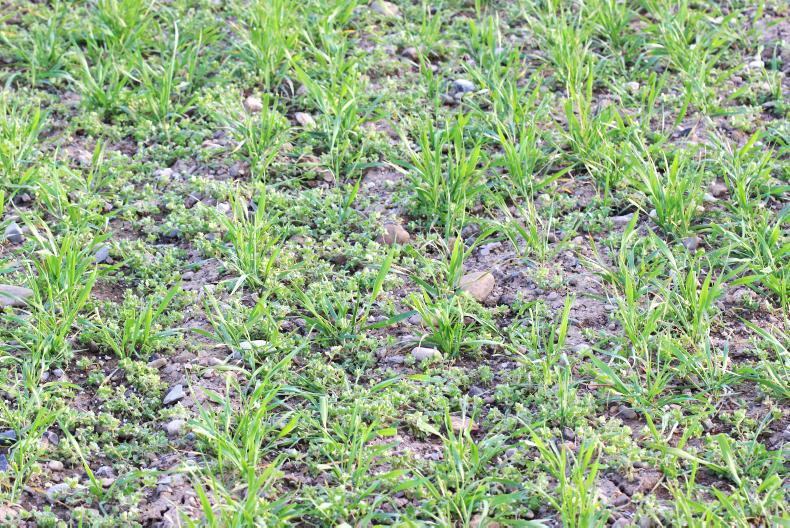Getting out and about is something that I really enjoy at this time of year but government guidelines to help protect us all from the ravages of this deadly virus mean I cannot move too far.
But like most others, I fully understand that we must do this to help keep others safe so that important people such as health workers and farmers can continue to go about their essential daily work.
In compliance with these guidelines, and with the 2020 Crop Protection magazine (which will be in the edition of 18 April) put to bed last week, I took a much-needed walk within my 2km allowance to visit a field of winter wheat.
I saw this field being drilled last backend but I am not sure when. But I do know that it was after oilseed rape.

The bulk of the field had a full crop with thin patches interspersed through it.
This big field had all the variability that one might expect in a winter crop this year. So three or four bare patches, but hardly half an acre between them, and maybe 5% to 10% of the field could be described as thin.
The bulk of the crop was in relatively good shape. The stronger plants nearly all had two tillers but where the crop was thin, most plants still had no tiller.

Most of the crop had good full rows of wheat plants with two tillers present.
It would seem that these areas, which were totally random throughout the field, probably related to excessive wetness which hit both establishment and growth all winter.
While the thin areas will remain on the thin side through to harvest, I have little doubt but that this crop will turn inside out before we see July.
I expect that even those plants which look weak with no tillers today will probably carry four to five very respectable tillers into the harvest.
One other thing that was particularly noticeable about this crop was the impact that shelter had made to the level of growth.

Areas of the field which may have been associated with excessive wet over winter had poor establishment and no tillering visible yet.
The plants in these areas were over 15cm tall and one could barely see the rows as the plants danced about in the wind.
But it must be said too that some of this was etiolation, which is the plant growing taller in search of light in a shaded and sheltered area.
Slugs
A wheat crop following oilseed rape is always at risk from slug attack. The risk was bigger in this field because there had been a big volume of volunteer rape regrowth.
While there was some evidence of slug damage as leaf stripping, this was minor in terms of the overall crop.
I would say that the pellets were a good investment
My guess is that the crop received slug pellets as I could see some old tracks of a quad across the field, possibly in anticipation of this problem.
I would say that the pellets were a good investment because the bulk of the crop is now fine, except for the areas where water may have been the biggest problem.
Weeds
When I walked into the field I was of the opinion that the weeds had not been sprayed.
The main weeds present were field speedwell, fumitory, one of the soft thistles, annual meadow grass and other things that looked like a variant of poppy.

The vast majority of the crop that had been sprayed with herbicide was perfectly clean and free of weeds except for one pocket which was a forest of ivy-leaved speedwell.
As I walked from tramline to tramline, it was obvious that there were far fewer weeds and then no weeds, even no meadow grass.
That forced me to wonder if part of the field had been sprayed with herbicide.
A closer look at the tramtracks showed that there had been two passes, one recent for fertiliser and one much older, which was most likely herbicide. And the whole field was the same.
My considered guess is that the weeds on the headland had been sprayed but with the water that was in the boom sections before the spray came through.
There was no other weed present, which probably means that is not just a miss with a boom section
So that was largely the story of the weed control with one definite exception. As I walked across the tramlines, I hit one streak which ran along the tramlines about halfway between two set of tramtracks.
This streak was a total nest of ivy-leaved speedwell among the wheat plants. There was no other weed present, which probably means that is not just a miss with a boom section.
This was the equivalent of a nest or a hotspot or, using modern day lingo, a cluster.
I look forward to visiting this crop again in two to three weeks and to monitor its progress if we remain confined in our travels.
A typical crop of winter wheat with mainly adequate plant population, a small proportion of the crop was thin and a very small amount was blank.The thin areas were 70 to 80 plants per square metre, but these could still push up to 90% yield potential. Weed control was generally very good but there was one very severe patch of ivy-leaved speedwell in the crop.
Getting out and about is something that I really enjoy at this time of year but government guidelines to help protect us all from the ravages of this deadly virus mean I cannot move too far.
But like most others, I fully understand that we must do this to help keep others safe so that important people such as health workers and farmers can continue to go about their essential daily work.
In compliance with these guidelines, and with the 2020 Crop Protection magazine (which will be in the edition of 18 April) put to bed last week, I took a much-needed walk within my 2km allowance to visit a field of winter wheat.
I saw this field being drilled last backend but I am not sure when. But I do know that it was after oilseed rape.

The bulk of the field had a full crop with thin patches interspersed through it.
This big field had all the variability that one might expect in a winter crop this year. So three or four bare patches, but hardly half an acre between them, and maybe 5% to 10% of the field could be described as thin.
The bulk of the crop was in relatively good shape. The stronger plants nearly all had two tillers but where the crop was thin, most plants still had no tiller.

Most of the crop had good full rows of wheat plants with two tillers present.
It would seem that these areas, which were totally random throughout the field, probably related to excessive wetness which hit both establishment and growth all winter.
While the thin areas will remain on the thin side through to harvest, I have little doubt but that this crop will turn inside out before we see July.
I expect that even those plants which look weak with no tillers today will probably carry four to five very respectable tillers into the harvest.
One other thing that was particularly noticeable about this crop was the impact that shelter had made to the level of growth.

Areas of the field which may have been associated with excessive wet over winter had poor establishment and no tillering visible yet.
The plants in these areas were over 15cm tall and one could barely see the rows as the plants danced about in the wind.
But it must be said too that some of this was etiolation, which is the plant growing taller in search of light in a shaded and sheltered area.
Slugs
A wheat crop following oilseed rape is always at risk from slug attack. The risk was bigger in this field because there had been a big volume of volunteer rape regrowth.
While there was some evidence of slug damage as leaf stripping, this was minor in terms of the overall crop.
I would say that the pellets were a good investment
My guess is that the crop received slug pellets as I could see some old tracks of a quad across the field, possibly in anticipation of this problem.
I would say that the pellets were a good investment because the bulk of the crop is now fine, except for the areas where water may have been the biggest problem.
Weeds
When I walked into the field I was of the opinion that the weeds had not been sprayed.
The main weeds present were field speedwell, fumitory, one of the soft thistles, annual meadow grass and other things that looked like a variant of poppy.

The vast majority of the crop that had been sprayed with herbicide was perfectly clean and free of weeds except for one pocket which was a forest of ivy-leaved speedwell.
As I walked from tramline to tramline, it was obvious that there were far fewer weeds and then no weeds, even no meadow grass.
That forced me to wonder if part of the field had been sprayed with herbicide.
A closer look at the tramtracks showed that there had been two passes, one recent for fertiliser and one much older, which was most likely herbicide. And the whole field was the same.
My considered guess is that the weeds on the headland had been sprayed but with the water that was in the boom sections before the spray came through.
There was no other weed present, which probably means that is not just a miss with a boom section
So that was largely the story of the weed control with one definite exception. As I walked across the tramlines, I hit one streak which ran along the tramlines about halfway between two set of tramtracks.
This streak was a total nest of ivy-leaved speedwell among the wheat plants. There was no other weed present, which probably means that is not just a miss with a boom section.
This was the equivalent of a nest or a hotspot or, using modern day lingo, a cluster.
I look forward to visiting this crop again in two to three weeks and to monitor its progress if we remain confined in our travels.
A typical crop of winter wheat with mainly adequate plant population, a small proportion of the crop was thin and a very small amount was blank.The thin areas were 70 to 80 plants per square metre, but these could still push up to 90% yield potential. Weed control was generally very good but there was one very severe patch of ivy-leaved speedwell in the crop. 









 This is a subscriber-only article
This is a subscriber-only article










SHARING OPTIONS: